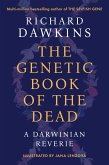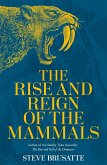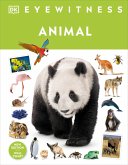- Broschiertes Buch
- Merkliste
- Auf die Merkliste
- Bewerten Bewerten
- Teilen
- Produkt teilen
- Produkterinnerung
- Produkterinnerung
Integrated Principles of Zoology is considered the standard by which other texts are measured. With its comprehensive coverage of biological and zoological principles, mechanisms of evolution, diversity, physiology, and ecology, organized into five parts for easy access, this text is suitable for one- or two-semester introductory courses.
Andere Kunden interessierten sich auch für
![The Genetic Book of the Dead The Genetic Book of the Dead]() Richard DawkinsThe Genetic Book of the Dead21,99 €
Richard DawkinsThe Genetic Book of the Dead21,99 €![The Universal History of Us The Universal History of Us]() Tim CoulsonThe Universal History of Us29,99 €
Tim CoulsonThe Universal History of Us29,99 €![The Rise and Reign of the Mammals The Rise and Reign of the Mammals]() Steve BrusatteThe Rise and Reign of the Mammals28,99 €
Steve BrusatteThe Rise and Reign of the Mammals28,99 €![A Brief History of Earth A Brief History of Earth]() Andrew H. KnollA Brief History of Earth20,99 €
Andrew H. KnollA Brief History of Earth20,99 €![Animal Animal]() DKAnimal11,99 €
DKAnimal11,99 €![The Rise and Reign of the Mammals The Rise and Reign of the Mammals]() Steve BrusatteThe Rise and Reign of the Mammals38,99 €
Steve BrusatteThe Rise and Reign of the Mammals38,99 €![The Rise and Reign of the Mammals The Rise and Reign of the Mammals]() Steve BrusatteThe Rise and Reign of the Mammals33,99 €
Steve BrusatteThe Rise and Reign of the Mammals33,99 €-
-
-
Integrated Principles of Zoology is considered the standard by which other texts are measured. With its comprehensive coverage of biological and zoological principles, mechanisms of evolution, diversity, physiology, and ecology, organized into five parts for easy access, this text is suitable for one- or two-semester introductory courses.
Produktdetails
- Produktdetails
- Verlag: McGraw-Hill Education
- 19 ed
- Seitenzahl: 944
- Erscheinungstermin: 17. März 2023
- Englisch
- Abmessung: 227mm x 276mm x 33mm
- Gewicht: 1814g
- ISBN-13: 9781266263293
- ISBN-10: 1266263292
- Artikelnr.: 66454243
- Herstellerkennzeichnung
- Libri GmbH
- Europaallee 1
- 36244 Bad Hersfeld
- gpsr@libri.de
- Verlag: McGraw-Hill Education
- 19 ed
- Seitenzahl: 944
- Erscheinungstermin: 17. März 2023
- Englisch
- Abmessung: 227mm x 276mm x 33mm
- Gewicht: 1814g
- ISBN-13: 9781266263293
- ISBN-10: 1266263292
- Artikelnr.: 66454243
- Herstellerkennzeichnung
- Libri GmbH
- Europaallee 1
- 36244 Bad Hersfeld
- gpsr@libri.de
Cleveland P. Hickman, Jr., Professor Emeritus of Biology at Washington and Lee University in Lexington, Virginia, has taught zoology and animal physiology for more than 30 years. He received his Ph.D. in comparative physiology from the University of British Columbia, Vancouver, B.C., in 1958 and taught animal physiology at the University of Alberta before moving to Washington and Lee University in 1967. He has published numerous articles and research papers in fish physiology, in addition to co-authoring these highly successful texts: Integrated Principles of Zoology, Biology of Animals, Animal Diversity, Laboratory Studies in Animal Diversity, and Laboratory Studies in Integrated Principles of Zoology.
PART ONE
Introduction to Living Animals
1 Life: Biological Principles and the Science of Zoology
2 The Origin and Chemistry of Life
3 Cells as Units of Life
4 Cellular Metabolism
PART TWO
Continuity and Evolution of Animal Life
5 Genetics: A Review
6 Organic Evolution
7 The Reproductive Process
8 Principles of Development
PART THREE
Diversity of Animal Life
9 Architectural Pattern of an Animal
10 Taxonomy and Phylogeny of Animals
11 Unicellular Eukaryotes
12 Sponges and Placozoans
13 Radiate Animals
14 Acoelomorpha and Mesozoa
15 Polyzoa and Kryptrochozoa
16 Molluscs
17 Annelids and Allied Taxa
18 Smaller Ecdysozoans
19 Trilobites, Chelicerates, and Myriapods
20 Crustaceans
21 Hexapods
22 Echinoderms, and Hemichordates
23 Chordates
24 Fishes
25 Early Tetrapods and Modern Amphibians
26 Amniote Origins and Nonavian Reptiles
27 Birds
28 Mammals
PART FOUR
Activity of Life
29 Support, Protection, and Movement
30 Homeostasis: Osmotic Regulation, Excretion, and Temperature Regulation
31 Homeostasis: Internal Fluids and Respiration
32 Digestion and Nutrition
33 Nervous Coordination: Nervous System and Sense Organs
34 Chemical Coordination: Endocrine System
35 Immunity
36 Animal Behavior
PART FIVE
Animals and Their Environments
37 Animal Distributions
38 Animal Ecology
Introduction to Living Animals
1 Life: Biological Principles and the Science of Zoology
2 The Origin and Chemistry of Life
3 Cells as Units of Life
4 Cellular Metabolism
PART TWO
Continuity and Evolution of Animal Life
5 Genetics: A Review
6 Organic Evolution
7 The Reproductive Process
8 Principles of Development
PART THREE
Diversity of Animal Life
9 Architectural Pattern of an Animal
10 Taxonomy and Phylogeny of Animals
11 Unicellular Eukaryotes
12 Sponges and Placozoans
13 Radiate Animals
14 Acoelomorpha and Mesozoa
15 Polyzoa and Kryptrochozoa
16 Molluscs
17 Annelids and Allied Taxa
18 Smaller Ecdysozoans
19 Trilobites, Chelicerates, and Myriapods
20 Crustaceans
21 Hexapods
22 Echinoderms, and Hemichordates
23 Chordates
24 Fishes
25 Early Tetrapods and Modern Amphibians
26 Amniote Origins and Nonavian Reptiles
27 Birds
28 Mammals
PART FOUR
Activity of Life
29 Support, Protection, and Movement
30 Homeostasis: Osmotic Regulation, Excretion, and Temperature Regulation
31 Homeostasis: Internal Fluids and Respiration
32 Digestion and Nutrition
33 Nervous Coordination: Nervous System and Sense Organs
34 Chemical Coordination: Endocrine System
35 Immunity
36 Animal Behavior
PART FIVE
Animals and Their Environments
37 Animal Distributions
38 Animal Ecology
PART ONE
Introduction to Living Animals
1 Life: Biological Principles and the Science of Zoology
2 The Origin and Chemistry of Life
3 Cells as Units of Life
4 Cellular Metabolism
PART TWO
Continuity and Evolution of Animal Life
5 Genetics: A Review
6 Organic Evolution
7 The Reproductive Process
8 Principles of Development
PART THREE
Diversity of Animal Life
9 Architectural Pattern of an Animal
10 Taxonomy and Phylogeny of Animals
11 Unicellular Eukaryotes
12 Sponges and Placozoans
13 Radiate Animals
14 Acoelomorpha and Mesozoa
15 Polyzoa and Kryptrochozoa
16 Molluscs
17 Annelids and Allied Taxa
18 Smaller Ecdysozoans
19 Trilobites, Chelicerates, and Myriapods
20 Crustaceans
21 Hexapods
22 Echinoderms, and Hemichordates
23 Chordates
24 Fishes
25 Early Tetrapods and Modern Amphibians
26 Amniote Origins and Nonavian Reptiles
27 Birds
28 Mammals
PART FOUR
Activity of Life
29 Support, Protection, and Movement
30 Homeostasis: Osmotic Regulation, Excretion, and Temperature Regulation
31 Homeostasis: Internal Fluids and Respiration
32 Digestion and Nutrition
33 Nervous Coordination: Nervous System and Sense Organs
34 Chemical Coordination: Endocrine System
35 Immunity
36 Animal Behavior
PART FIVE
Animals and Their Environments
37 Animal Distributions
38 Animal Ecology
Introduction to Living Animals
1 Life: Biological Principles and the Science of Zoology
2 The Origin and Chemistry of Life
3 Cells as Units of Life
4 Cellular Metabolism
PART TWO
Continuity and Evolution of Animal Life
5 Genetics: A Review
6 Organic Evolution
7 The Reproductive Process
8 Principles of Development
PART THREE
Diversity of Animal Life
9 Architectural Pattern of an Animal
10 Taxonomy and Phylogeny of Animals
11 Unicellular Eukaryotes
12 Sponges and Placozoans
13 Radiate Animals
14 Acoelomorpha and Mesozoa
15 Polyzoa and Kryptrochozoa
16 Molluscs
17 Annelids and Allied Taxa
18 Smaller Ecdysozoans
19 Trilobites, Chelicerates, and Myriapods
20 Crustaceans
21 Hexapods
22 Echinoderms, and Hemichordates
23 Chordates
24 Fishes
25 Early Tetrapods and Modern Amphibians
26 Amniote Origins and Nonavian Reptiles
27 Birds
28 Mammals
PART FOUR
Activity of Life
29 Support, Protection, and Movement
30 Homeostasis: Osmotic Regulation, Excretion, and Temperature Regulation
31 Homeostasis: Internal Fluids and Respiration
32 Digestion and Nutrition
33 Nervous Coordination: Nervous System and Sense Organs
34 Chemical Coordination: Endocrine System
35 Immunity
36 Animal Behavior
PART FIVE
Animals and Their Environments
37 Animal Distributions
38 Animal Ecology








